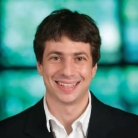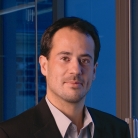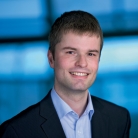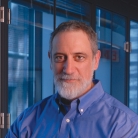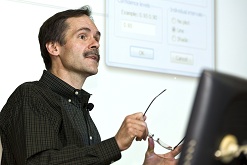How do you build interactive applications like Gmail and Google Maps that only require a browser?
Many modern applications, whether targeted at mobile or Web scenarios, make use of sophisticated clusters of servers in “data centers” located across the world. In NETS 212, Scalable and Cloud Computing, you will learn about different tiers of cloud computing services, how to harness the power of a cluster in solving “big data” problems, and how to build scalable Web-based services. The course culminates in a final project, typically the construction of a cloud-based platform such as a Facebook-style social network.
How do Facebook and Google+ do their recommendations?
In making recommendations, social network recommendations take into account many factors, including how much commonality there is between potential friends, etc. A detailed breakdown of some of Facebook’s Friend Rank parameters is here However, the basis of virtually all recommendations is the notion of triadic closure, where it is observed that two people with a common friend are more likely to be friends (or potential friends). We study this notion in detail, and develop friend recommendation algorithms in NETS 150, Market and Social Systems on the Internet and in a social networks project in NETS 212, Scalable and Cloud Computing.
What problems can be solved by crowd sourcing?
One of the most exciting new developments is the study of how humans can aid algorithms or computer systems in solving tasks where humans are very good and machines are not — e.g., recognizing objects in video. Amazing successes have been had in areas like understanding how proteins fold (see FoldIt). Others are using Amazon’s Mechanical Turk service (and its competitors) to pay people to perform small tasks. CIS 399 explores how human and computational methods can be used to solve difficult problems — including how to divide up problems, cross-validate results, and more.
How can we optimally allocate goods in a market that does not allow the transfer of money?
In many markets, like those for jobs, spouses, and college admissions, you can’t simply choose (and buy) the item you want — you also have to be chosen. In NETS 150 and NETS 412, we will explore how to efficiently organize such markets to make sure that resources are allocated to where they will do the most good, all while preventing any participant in the market from being able to game the system by misrepresenting his preferences.
How much will shutting down a road increase traffic in the rest of the road network?
In NETS 412, we will study traffic routing games in which selfish agents greedily try to optimize their own commute time, which might not necessarily optimize the overall health of the network. We will study the equilibrium traffic patterns in different networks, and observe the strange effect known as Braess Paradox, which tells us that sometimes closing down a road can actually decrease traffic elsewhere in the network, at equilibrium.
How have search engines revolutionized advertising?
As you will learn in NETS 150: Market and Social Systems on the Internet and NETS 412: Algorithmic Game Theory, Google, Bing, Yahoo, Yandex, Baidu, and others make money by charging advertisers whenever a search engine user clicks on an ad placed with the search results. Building on ideas from game theory and auctions, the price of the ad depends on the value of the ad to the advertiser. This value will depend on how competitive the market is, how likely people are to make a purchase after clicking on the ad, and so on. Most search engines use a particular algorithm called Generalized Second Price to choose how much to charge an advertiser: the advertiser who gets the best positioning pays the amount bid by the second-highest bidder, the advertiser who gets the second best positioning pays the amount bid by the third-highest bidder, and so on.
What do computer networks, biological networks and social networks have in common?
Empirical studies of very disparate networked systems such as the Internet, social networks, and biological networks indicate the presence of universal structural patterns. Researchers have then developed a variety of techniques to help us understand and predict the behavior of all these networks. In NETS 312, we study recent developments in this field, including such concepts as the small-world effect, degree distributions, clustering, network correlations, random graph models, models of network growth and preferential attachment, and dynamical processes taking place on networks.
How does information propagate in Twitter’s network?
Twitter can be represented as a directed social network where nodes are the users of the service and edges represent “following” relationships. In NETS 312, we provide tools to study the propagation of information over the Twitter social network. For example, we consider the set of users (i.e., nodes in the network) who mention a particular tag in some chronological order, their distribution over the network, and the presence/absence of edges between them.
